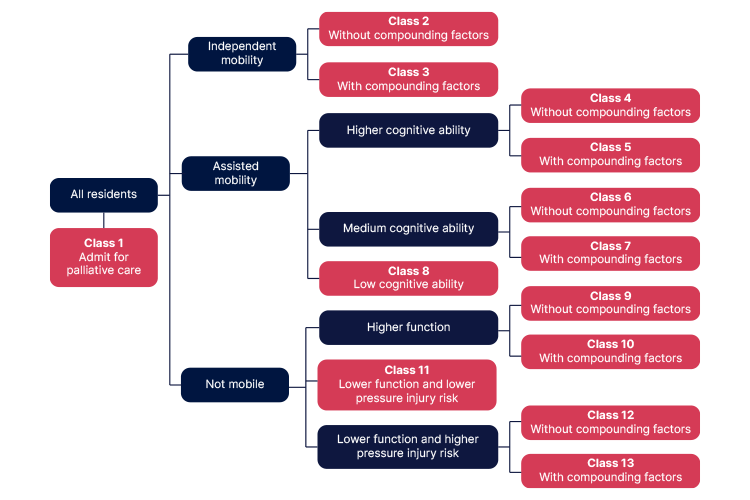The Australian National Aged Care Classification (AN-ACC) was introduced in October 2022, replacing the Aged Care Funding Instrument (ACFI) (DHAC 2023a).
What is the Australian National Aged Care Classification?
The AN-ACC assesses the degree of care required by each aged care resident and, based on this assessment, allocates funding to the facility providing their care (DHAC 2023b).
These subsidies incorporate three components:
- Base Care Tariff (BCT): A fixed funding component covering shared care costs that do not vary much between residents. The BCT may depend on factors such as the provider’s location and the need for specialist services (e.g. Aboriginal and Torres Strait Islander services).
- The AN-ACC classification subsidy: Variable funding to cover the costs of each resident’s individual care needs and minimum care minute requirements. This is determined based on an assessment where the resident will be aligned with one of 13 classes of care.
- One-off entry adjustment payment: This is made each time a new permanent resident enters the facility to cover one-off transition costs.
(DHAC 2024; Edwards 2022)

Why was the Aged Care Funding Instrument Replaced?
Since the introduction of the ACFI in 2008, the care needs of older people entering residential aged care have changed significantly (Eager et al. 2020).
This is largely due to the success of home care programs that allow older people to live at home independently for longer. Therefore, when they do eventually enter residential aged care, they are older and frailer (half of all new residents are over the age of 84) and typically pass away within two years of admission (Eager et al. 2020).
Furthermore, a review in 2017 found that the existing ACFI model was no longer ‘fit for purpose’ due to several factors, including:
- Being unable to properly discriminate between the care needs of residents
- Administrative inefficiency
- Perverse incentives (e.g. reducing funding if a resident’s functioning improves, meaning that providers were ‘rewarded’ for failing to prevent or improve certain conditions and behaviours).
(Eager et al. 2020; Loggie et al. 2021)
In response to these issues, the Australian Government Department of Health engaged the Australian Health Services Research Institute (AHSRI) at the University of Wollongong to design a new and more appropriate funding model (Loggie et al. 2021).
The AN-ACC Assessment Tool
The AN-ACC Assessment Tool is used to assess an individual resident’s care needs to determine the amount of variable funding that needs to be allocated to their provider (i.e. their AN-ACC classification subsidy). Based on this assessment, the resident will be assigned to one of 13 classes of variable funding (DHAC 2023b, 2024).
These assessments are performed by independent aged care assessors (who are not related to the resident’s aged care provider) (DHAC 2024).
The AN-ACC assessment tool takes into account:
- Physical ability (including pain)
- Cognitive ability (including memory, communication, sequencing, social skills and problem-solving)
- Behaviour (including cooperation, agitation, wandering, passive resistance and verbal aggression)
- Mental health (including depression and anxiety).
(DHAC 2024)
For information on the AN-ACC Assessment Tool and what it comprises, see the AN-ACC Reference Manual.
AN-ACC Variable Funding Classes
Each one of the 13 classes represents residents who have similar characteristics and care costs (DHAC 2024).
Every class is assigned a National Weighted Activity Unit (NWAU) based on the relative cost of providing care to residents in that class. The higher the NWAU, the more costly the resident.
As of October 2024, the classes are:

| Class | Description | NWAU | AN-ACC subsidy amount (Rounded to the nearest cent per person per day) |
|---|---|---|---|
| Class 1 | Admitted for palliative care | 0.80 | $224.01 |
| Class 2 | Independent mobility without compounding factors | 0.19 | $53.20 |
| Class 3 | Independent mobility with compounding factors | 0.37 | $103.60 |
| Class 4 | Assisted mobility and higher cognitive ability without compounding factors | 0.25 | $70.00 |
| Class 5 | Assisted mobility and higher cognitive ability with compounding factors | 0.44 | $123.20 |
| Class 6 | Assisted mobility and medium cognitive ability without compounding factors | 0.40 | $112.00 |
| Class 7 | Assisted mobility and medium cognitive ability without compounding factors | 0.55 | $154.01 |
| Class 8 | Assisted mobility and low cognitive ability | 0.64 | $179.21 |
| Class 9 | Not mobile and higher function without compounding factors | 0.52 | $145.61 |
| Class 10 | Not mobile and higher function with compounding factors | 0.70 | $196.01 |
| Class 11 | Not mobile, lower function and lower pressure injury risk | 0.66 | $184.81 |
| Class 12 | Not mobile, lower function and higher pressure injury risk without compounding factors | 0.66 | $184.81 |
| Class 13 | Not mobile, lower function and higher pressure injury risk with compounding factors | 0.80 | $224.01 |
(Adapted from DHAC 2024)
Note: The term ‘compounding factors’ refers to ‘the combined incremental resource use associated with other independent variables’, which includes frailty, falls, daily injections, wound management, behavioural issues and other variables (Eager et al. 2020).
Test Your Knowledge
Question 1 of 3
True or false: Older people who are entering aged care are older and frailer than they were one decade ago.
Topics
References
- Department of Health and Aged Care 2023a, Residential Aged Care Funding Reform, Australian Government, viewed 25 November 2024, https://www.health.gov.au/topics/aged-care/aged-care-reforms-and-reviews/residential-aged-care-funding-reform
- Department of Health and Aged Care 2023b, AN-ACC Assessments, Australian Government, viewed 25 November 2024, https://www.health.gov.au/our-work/AN-ACC/providers/assessments
- Department of Health and Aged Care 2024, The Australian National Aged Care Classification (AN-ACC) Funding Guide, Australian Government, viewed 26 November 2024, https://www.health.gov.au/resources/publications/the-australian-national-aged-care-classification-an-acc-funding-guide?language=en
- Eager, K, Gordon, R, Snoek, MF et al. 2020, ‘The Australian National Aged Care Classification (AN-ACC): A New Casemix classification for residential Aged Care’, Medical Journal of Australia, vol. 213, no. 8, viewed 26 November 2024, https://www.mja.com.au/journal/2020/213/8/australian-national-aged-care-classification-acc-new-casemix-classification
- Edwards, N 2022, ‘New AN-ACC Funding Model Commenced 1 October 2022: A Summary for Aged Care Providers’, Aged Care Essentials, 4 October, viewed 26 November 2024, https://www.agedcareessentials.com.au/news/new-an-acc-funding-model-commenced-1-october-2022-a-summary-for-aged-care-providers
- Loggie, C, Westera, A, Kobel, C & Eager, K 2021, ‘The New Aged Care Funding Model Explained’, Australian Journal of Dementia Care, vol. 10, no. 3, viewed 26 November 2024, https://journalofdementiacare.com/the-australian-national-aged-care-classification-an-acc-an-overview/
 New
New 
